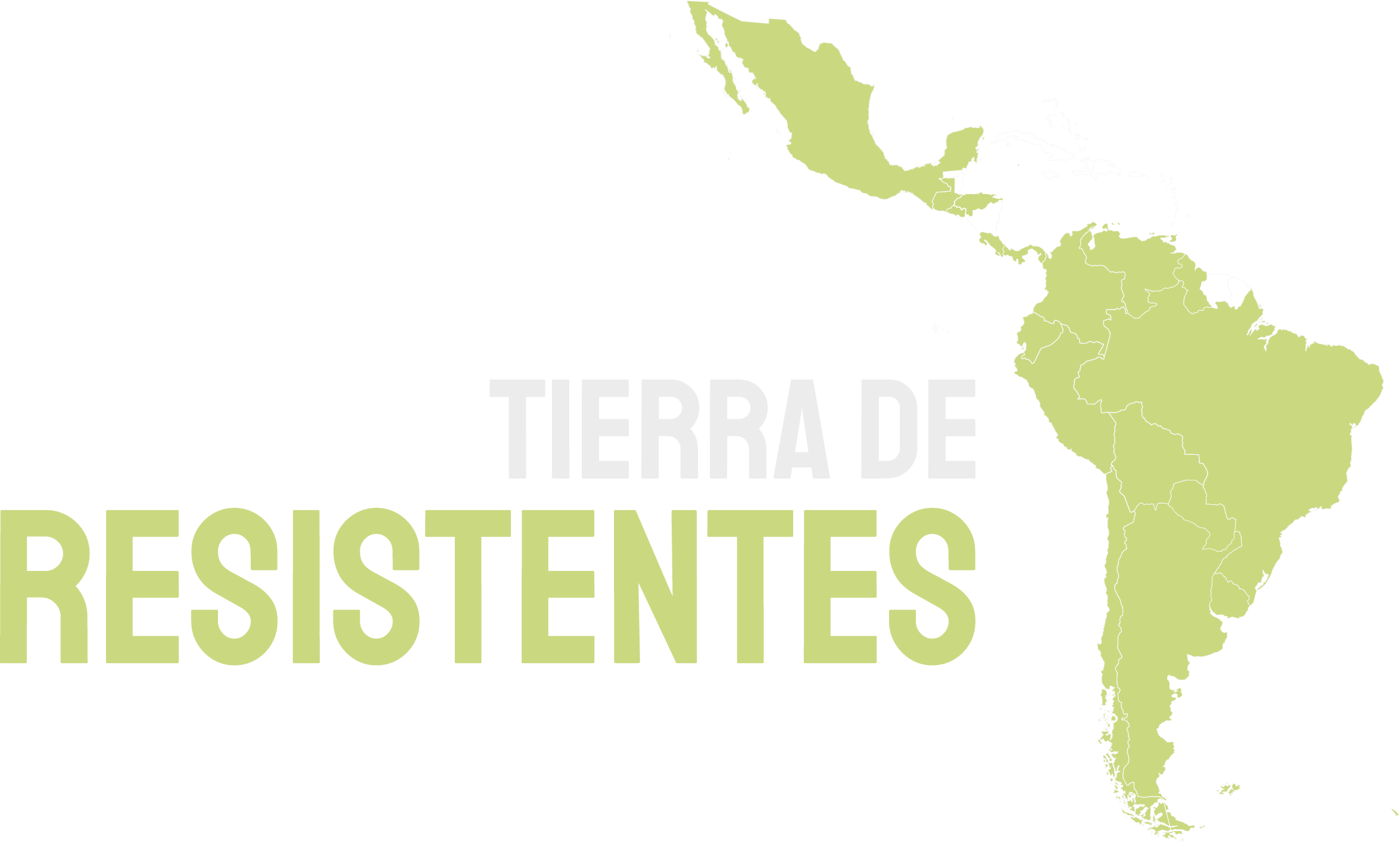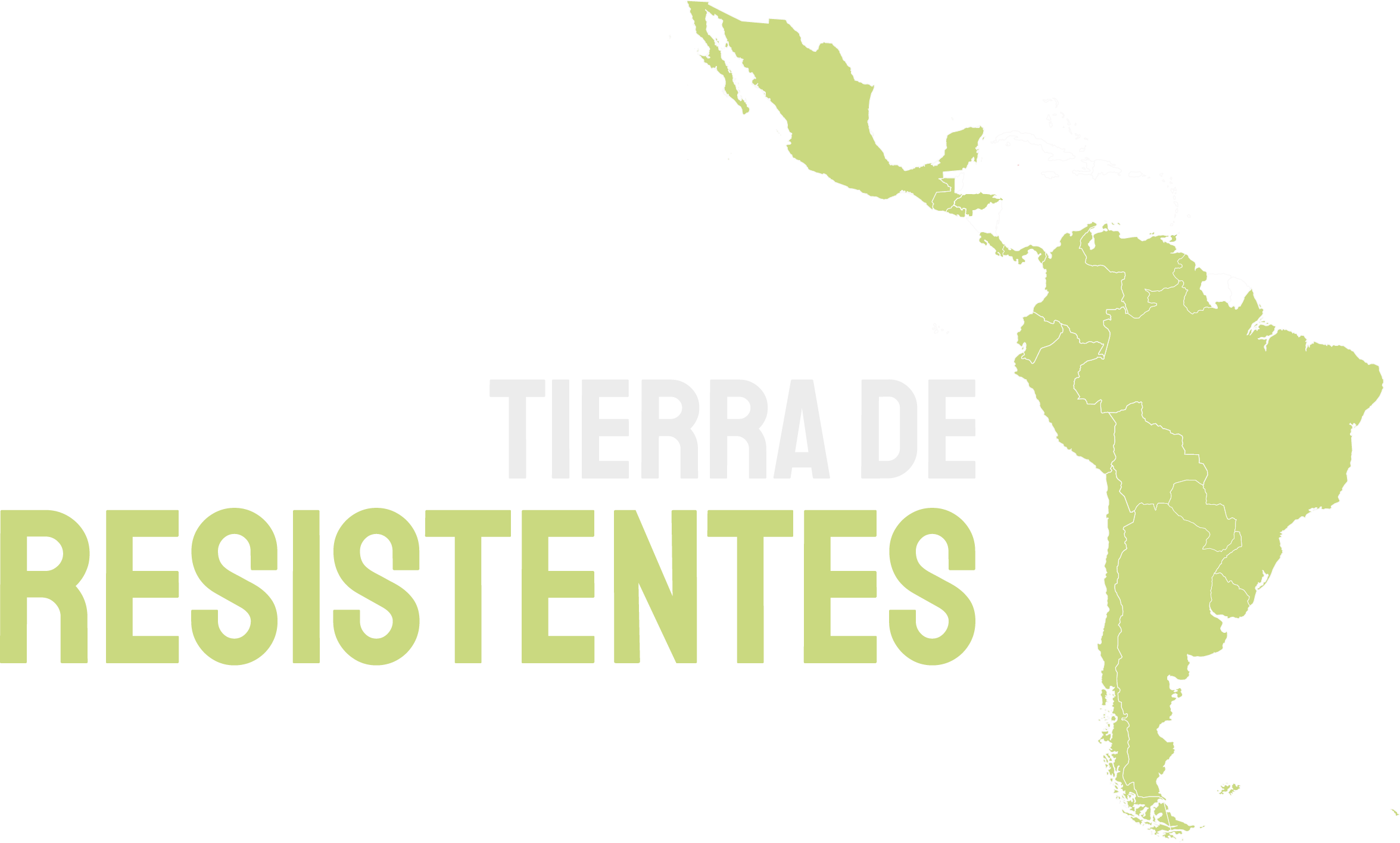In 2016 a Shuar community in southern Ecuador was attacked, forcibly evicted and legally harassed. A mining company was set up in their territory. More than two years later, its 32 inhabitants have not been able to return to their land.
When Sandro Chinkim returned to his village, his village no longer existed. Chinkim, a father in his thirties, had just left his community, Nankints, a day earlier to visit his in-laws, who live only 100 kilometers away. “When I returned, there was no house, and all the houses were buried. There was no board,” he said. Thirty-two people lived in Nankints, a tiny enclave of Shuar Indians in the foothills of the Condor Mountain Range in Ecuador’s southern Amazon. But when Chinkim returned there was no trace of them, nor of their houses. There were soldiers, policemen, and remains of wood and zinc, perhaps the only evidence that there used to be a community there. It was Aug. 13, 2016.
Forty-eight hours earlier, a picket line of policemen, brandishing a court order, had evicted the community. The land, they were told, was owned by the miningcompany Explorcobres S.A., and they were invading it. Unlike their son, Sandro Chinkim’s parents were in Nankints.
“They were told they had two minutes to get their stuff and get out”
Sandro Chinkim.
“They were told they had two minutes to get their stuff and get out,” said Chinkim. “Then they (authorities) knocked down the houses, buried them in a hole that they covered with dirt.” On that day, Aug. 11, 2016, the eight Nankints families took refuge in neighboring towns like San Carlos de Limón, Santiago de Pananza and Tsuntsuim. Nankints had ceased to exist. Their four small hectares became, by force of eviction, the mining camp La Esperanza.
Their people were never able to return to their homeland again.
Two-and-a-half years later, on a February morning in 2019, in what used to be Nankints, there are no longer any traces of wood and zinc. But there are seven small buildings with silver roofs, in the middle of tidy dirt roads, surrounded by a 2-meter-high metal fence reinforced with threatening barbed-wire spirals.
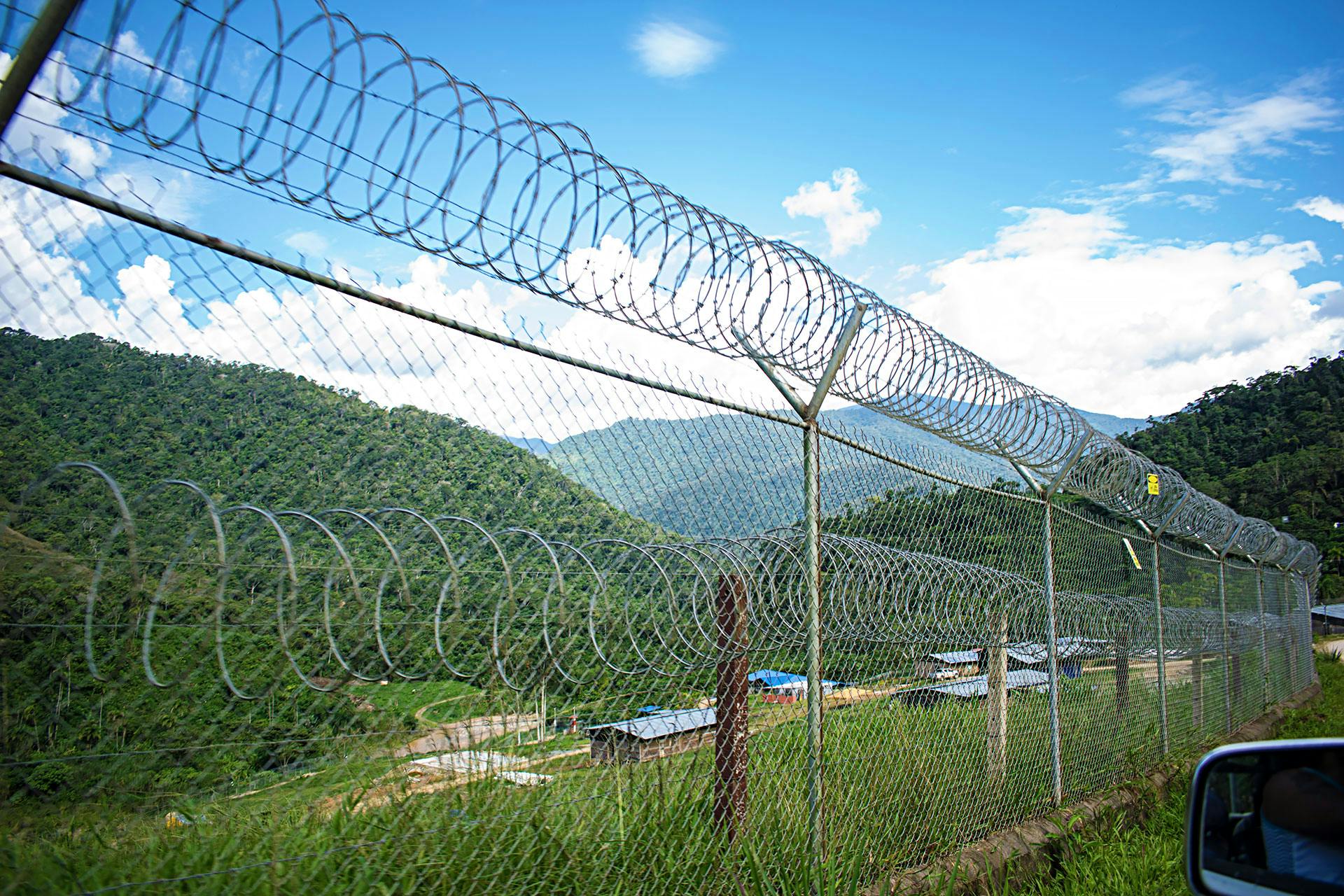
Inside a cement sentry box, a security guard watches suspiciously as a 4-by-4 rattles and lifts dust as it slowly passes outside the Panantza-San Carlos project camp, where Explorcobres S.A. wants to start exploiting the rich mountain range, replete with coveted copper, for 25 years.
At that moment began the violent escalation of a conflict between a powerful mining company and a small indigenous community, which would result in death, persecution, judicial harassment and displacement.
But the company can’t do it because of the resistance by the Shuar people. The forced eviction that left Sandro Chinkim homeless and without a town, was only the beginning of a four-month journey started that day in August 2016. At that moment began the violent escalation of a conflict between a powerful mining company and a small indigenous community, which would result in death, persecution, judicial harassment and displacement.
***
Jonathan, 6, and Steven, 4, laugh as they run free. On the grass that separates the houses from the court, a lady pulls a neighing mule. Rita, 21, squatting, machetes the grass around her house. A hen cackles.
In Tsuntsuim there is no health center, no grocery store. There is a small school for all children between the ages of 5 and 13.

On Aug. 11, 2016, the day the eight families were evicted from Nankints, some sought refuge in Tsuntsuim, about 6 kilometers away. Tsuntsium resident Alvino Pinchupá, remembers that “they (refugees from Nankints) arrived with only a blanket under their arm. “ ‘They kicked us out, it was an eviction’, they said, and we invited them to stay here.”
News of the displacement spread through the provinces of Morona Santiago and Zamora Chinchipe, part of the ancestral territory of the Shuars, one of Ecuador’s 15 indigenous nationalities. Nearly a dozen men, who were not from Nankints, went to Tsuntsuim to support their comrades and retake their community.
“Before what happened in Nankints, people were already talking and protesting the mining issue, but here someone had to decide and act”
Domingo Nayash.
Domingo Nayash had been the trustee – the highest administrative authority – of Tsuntsuim for barely a month, and he helped plan what he calls “the attack.” “Before what happened in Nankints, people were already talking and protesting the mining issue, but here someone had to decide and act,” said Nayash, a thin, brown, wide-nosed man with strong arms. He was sitting on a wooden bench, under a zinc roof from where newly washed t-shirts, trousers and wet socks hang. During the months after the eviction, there were assemblies and meetings between leaders of the Shuar organizations and the men who joined to defend their territory.
After weeks of planning, in the early hours of Sunday, Nov. 20, 2016, nearly 25 men left Tsuntsuim for La Esperanza. “It took us longer than expected because there were two chubby men walking slowly between us. We wanted to arrive at three in the morning to surprise the employees, but we arrived when it was already clear,” recalled Nayash.
Amid the shots, blows and intense confusion, the workers of Explorcobres S.A. and the policemen who guarded it fled in retreat.
It was 6 a.m., when the Shuar – some with spears, some with explosives and some with shotguns – burst into the mining camp. Amid the shots, blows and intense confusion, the workers of Explorcobres S.A. and the policemen who guarded it fled in retreat. The plan was to burn the houses, Nayash said, but someone in the group suggested saving them because they could serve the inhabitants of Nankints who, according to their plans, would return to re-found their community.
But the counterattack by the mining company and the State was strong-handed. After a night’s sleep in La Esperanza, the Shuar were surprised the next morning by a large contingent of police and military, according to Nayash. The Shuar seizure of La Esperanza lasted 24 hours.
The Shuar retreated to San Carlos de Limón, a small town of settlers and Shuar people that lies between Tsuntsuim and the space where Nankints existed.

San Carlos de Limón can be reached in three ways. The simplest and quickest way – which takes between 3 and 4 minutes – is to cross half a kilometer on a small open cable car 300 meters above the Zamora River. The 20-something men who were thrown out of the former Nankints took refuge in Limón for three weeks.
“We’re going to do one more attack,” said trustee Nayash, adding that several men had joined them from other communities. Twenty-four days later, on Dec. 14, 2016 the Shuar moved against La Esperanza. But this time the camp was guarded by thousands of police and military, and the confrontation was more violent. “The shooting was heard so far,” said Tsuntsuim resident Natalia Nankamai.
Two soldiers, five policemen and two Shuar were wounded. Police officer José Luis Mejía died from a gunshot. Each side blamed each other in the shooting.

***
That same day, Dec. 14, then-President Rafael Correa ordered a military increase in the area and a 30-day state of emergency in Morona Santiago province.
Three days later, on radio and television networks that broadcasted speeches Correa gave every Saturday to discuss his management and to chastise his enemies, he alleged that the Shuar were part of “an extremely violent armed group” and denied that this space was their ancestral territory. The then-police commander, Diego Mejía, said the Shuar had “large caliber weapons.” Alvino Pinchupá and Domingo Nayash insist that they only had carbines, dynamite and lances.
For them and the women and children of Tsuntsuim, those days of December 2016 are unforgettable. Nayash was in San Carlos de Limón when two days later he decided to leave Tsuntsuim to tell the others what had happened.
The road between the parish head and the community has stretches of deep and trapping mud, like fresh concrete with travelers surprised by slithery anacondas. Other stretches are steep and rocky, between steep gorges and prehistoric stones that are crossed by downed slippery tree trunks. The villagers take about 40 minutes to cross it, while outsiders can take up to four hours.
“They came with armored cars, with tanks destroying everything. They used three fronts to enter, they wanted to ambush us”
Domingo Nayash.
Nayash remembered that as he walked to Tsuntusim he heard shooting and the sound of whirling helicopter blades. “They came with armored cars, with tanks destroying everything. They used three fronts to enter, they wanted to ambush us,” Nayash said. The military and police broke into several towns in the area. Their objective was to arrest the suspects in the death of policeman José Luis Mejía.
Rosa Tuits, a resident of San Pedro, a community near Tsuntsuim, said she was bathing when the police and military kicked in her door. “That scared me,” she said. “Luckily I was there because the people who weren’t there had their doors broken, their hinges. In my house they checked and dismantled everything and took the carbine with them. We always have weapons because we live in the jungle and we have hens. That gun was taken.”
The then-Minister of the Interior, Diego Fuentes, published in his Twitter account: “We disprove any assertion and information of violent interventions on the part of the public force.”
The inhabitants of Tsuntsuim were afraid on that December day. The noise of helicopters, bullets and drones horrified the children. Around 8 p.m., the 27 families decided to leave their community. They didn’t want to run into the military or police. “The soldiers came with gunshots, the helicopters could be heard low. I had to take the children. What animals? What blankets? Nothing. We left with nothing and it was time to sleep in the mountain. The children without a snack,” remembered Benito Jimpikit, a member of the Tsuntsuim community. People were unable to pack clothes or food. Nothing, Nayash said, commenting that most didn’t have a flashlight to pierce the darkness as they stumbled through the thick jungle.
The next morning they arrived at Tink, another Shuar community 12.4 kilometers from Tsuntsuim, where they took refuge. “We didn’t know what was going to happen. I thought the next day I would come back to see my things, to bring food for my children,” Nayash said, but it took them four months to return to Tsuntsuim.
They returned only when they were sure that all the military had left the community.
***
The houses of Benito Jimpikit and three other villagers were burned down. “I had a kitchenette, fridge, seven cattle, 78 chickens. And when I returned, I received only 25 sheets of zinc to rebuild. I just started to recover,” Jimpkit said. Hidden that night from the military who still occupied Tsuntsuim, Jimpkit saw that he didn’t have a house, and there wasn’t a cow left in his herd. He went back to his wife and cried, heartbroken at all he had lost. “I cried like when you want to die that very moment,” Jimpkit said.

Maria Luisa Utitiaj, 61, sits at the wooden table next to her kitchenette surrounded by aluminum pots and bunches of plantains. In her hand, she has a closed lock attached to a hinge that she still keeps on the door that the military and police had knocked down. She was already sheltered in Tink when it happened, but she said they ate her chickens and took away her gas tanks. “They didn’t respect anything.”
Soledad Chumpik was the teacher at Tsuntsuim school. She spent Mondays through Fridays in the community and the weekends with her family in Gualaquiza, a nearby town. Chumpik was not there the day all the inhabitants fled to Tink but returned to the community two days later. The education district asked her to report on the school’s situation. When she arrived in Tsuntsuim, she said, it was full of soldiers and policemen. “They had invaded the houses, the school, all were in disarray,” she said. “The food I had was not in my room. Everything had been used by the police, who still occupied my room.” That night, Chumpik slept in Tsuntsuim. The next day, she took photographs of the school and wrote notes for the report she had been asked to make.

One morning in February in 2019, in the corridor of the Tsuntsuim school she still directs, Chumpik said she fulfilled the order given to her. “I wasn’t afraid to be there because I had nothing to do with it,” she said. However, police arrested Chumpik and took her handcuffed to a checkpoint in San Juan Bosco canton, where she slept one night. “The next day they took me to the hospital for check-ups, then to the Community Police Unit, then to the Attorney General’s Office,” she said. Chumpik’s husband took care of the paperwork and the lawyers. During the interrogations, she was asked to hand over evidence. “What evidence could I give them if I didn’t know anything?” asked Chumpik, who was charged with incitement to discord among citizens.
Later, while waiting for the children to finish a task before sending them on holiday for the end of the first half of the school year, she recalled how the police arrest affected the youngsters.
***
No national politician has stepped into Tsuntsuim. During election campaigns, some candidates for the parish council or prefects of the province have visited the community. But their visits have not translated into concrete works. It is enough to travel the muddy and impassable road up there to understand that taking care of residents is not a priority.
Perhaps the last time they received any attention was during the war over disputed territory with Peru that ended in 1998. The coveted region is very close to Tsuntsuim, and during the conflict the Shuar were recruited by the army. After the war, however, their support and contribution was not recognized, according to indigenous people in the area.
After the conflict in Nankints, said the father of five, many journalists, environmentalists and social activists arrived. “But here we are two years later, everything remains the same, we haven’t recovered and nobody cares,” he said.
***

***
Though the eviction of Nankints to set up La Esperanza camp was in 2016, the mining project has been going on for more than 10 years. It occupies nearly 42,000 hectares – three times the size of Miami. According to a report by the Tiam Foundation (which watches over human rights and the environment), four towns – Indanza, San Miguel de Conchay, San Carlos de Limón and San Jacinto de Wakambeis – are within the concession areas. Four others – San Antonio, Pan de Azúcar, San Juan Bosco and Santiago de Pananza – are within the project’s area of influence. More than 12,000 people would be affected, 5,000 of them Shuar.
The report concluded that the project has seven irregularities because the ministries involved failed to comply with legislation such as the Mining Mandate or the Constitution.
In 2012, the Comptroller General’s Office audited environmental aspects of the management of the Ministries of Environment, Energy and Non-Renewable Natural Resources and other institutions related to the Panantza-San Carlos mining project. The report concluded that the project has seven irregularities because the ministries involved failed to comply with legislation such as the Mining Mandate or the Constitution.
Specifically, according to the Comptroller General’s Office, the government had to suspend the project for reasons including: Explorcobres S.A. exceeded the number of concessions allowed under the mining mandate (a maximum of three were possible, and they had four in force and seven suspended); it is in a territory with births and water sources; and because the environmental impact study that was carried out was “outside the applicable legislation.”
The report makes it clear that in environmental, social – and even economic – terms, the project had been carried out to dubious standards.
By February 2019, Panantza-San Carlos was in an advanced exploration stage. It had already done the prospecting stage to determine if there are minerals in the soil and the exploration stage where trails are opened and boreholes are drilled.
In Ecuador, only one open-pit mine project has begun, and it is not far from Panantza-San Carlos, in the same Cordillera del Cóndor where Nankints used to be. It is concessioned to a different company, Ecuacorriente S.A., a subsidiary of the same Chinese conglomerate, and made up of the state-owned companies Tongling Nonferrous Metals – dedicated to metal mining – and China Railway Construction Corp. (CRCC) – dedicated to infrastructure construction. The two projects aim to exploit the same deposit, which extends beneath the provinces of Morona Santiago and Zamora Chinchipe, and is known as the “copper belt..”
Mirador has attracted more Ecuadorian public attention for the already-visible environmental damage and impact on surrounding communities. But Panantza-San Carlos is expected to double in extension and, therefore, in environmental damage, according to critics.
Mirador has attracted more Ecuadorian public attention for the already-visible environmental damage and impact on surrounding communities. But Panantza-San Carlos is expected to double in extension and, therefore, in environmental damage, according to critics. It has not been made public who chose the name La Esperanza for the camp. Many question whether the motivations were daughters of cynicism, contempt or abject arrogance.
***

***
Shuar resistance is not new. In November 2006, inhabitants of the Shuar community of Warints, also in the southern Amazon, arrived with lances and shotguns at the camp of the Canadian company Lowell Mineral Exploration and demanded that they leave their territory. Such was the pressure – they blocked the airplane runway to prevent the arrival of military and police – that the mining company left.
Mining has also created footprint of social problems in southern Ecuador.
Raúl Ankuash.
Raul Ankuash is one of the Shuar leaders who has been very close to anti-mining struggle and resistance. He is the territory leader of the Interprovincial Federation of Shuar Centres (Ficsh) and said that Shuar nationality has always rejected mining in their ancestral territory.“But the companies have generated internal divisions within the organization and continue to generate more conflicts. There is still one person financed by a company,” he said. Mining has also created footprint of social problems in southern Ecuador.
The conflict with Explorcobres S.A. is just a new twist of a long history. “If it weren’t for the resistance of the Shuar people, the Panantza-San Carlos project would have started a long time ago,” said Gloria Chicaiza of Acción Ecológica, an environmental rights organization. According to Chicaiza, the victory against Lowell had a cascading effect and interrupted the Panantza-San Carlos project, whose camp a decade ago, was called Rosa de Oro. “For the Shuar, these actions were a cleansing of territory. It was a way of making it clear that they wanted their land free of mining,” Chicaiza said.
Although Article 57 of Ecuador’s Constitution recognizes ancestral indigenous territories, the political history, especially that of lands in the Amazon, is more complex.
The area in southeastern Ecuador where mining companies want to dig deep, open-pit operations is the ancestral territory of the Shuar Arutam community, made up of some 13,000 Shuar people. Although Article 57 of Ecuador’s Constitution recognizes ancestral indigenous territories, the political history, especially that of lands in the Amazon, is more complex.
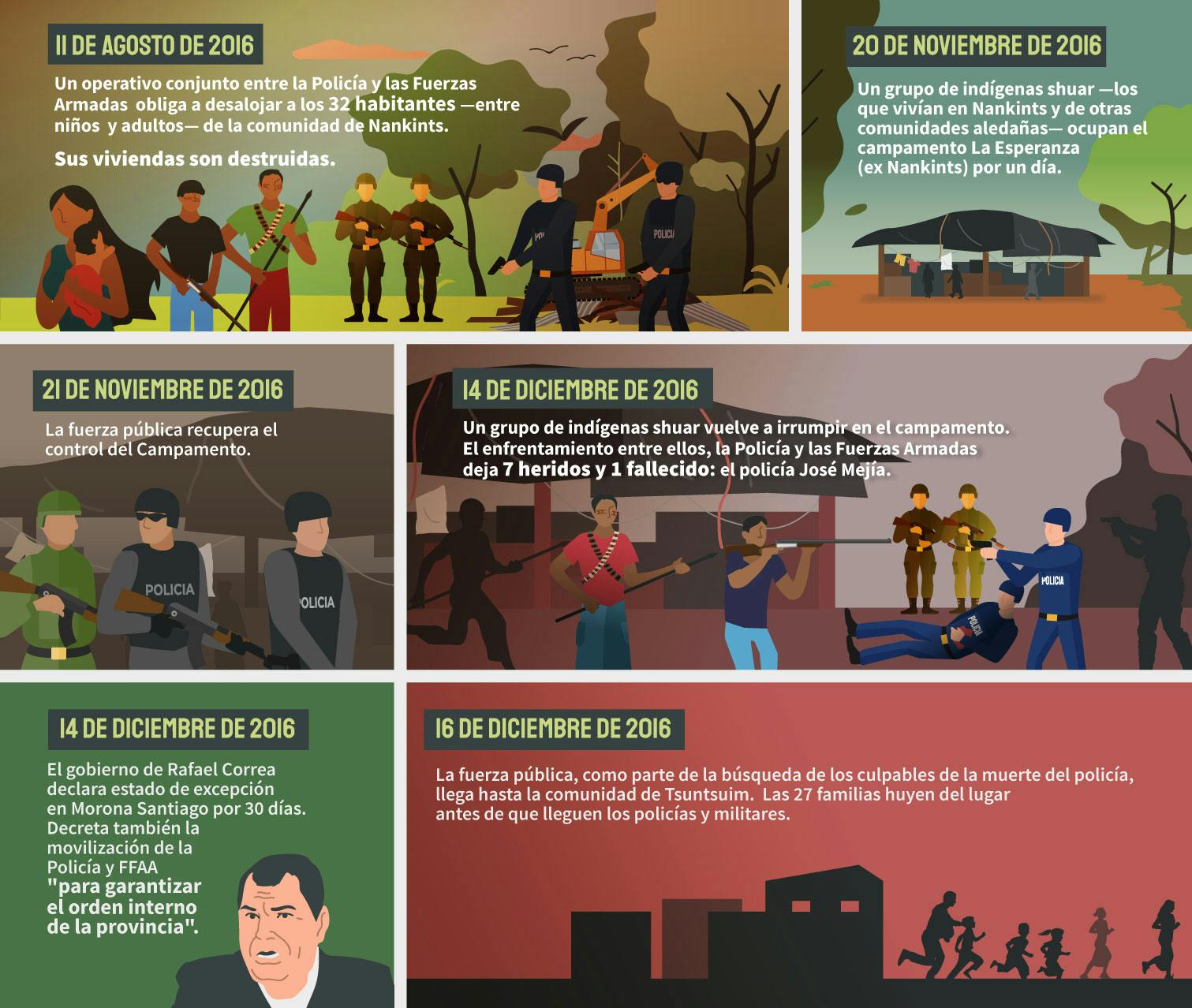
On Aug. 11, 2016, the joint operation evicted the inhabitants of Nankints because, according to the Ministry of the Interior, it was an “illegal invasion” because the properties had been granted to Explorcobres S.A. Ten years earlier, in November 2006, in the same space (now Camp La Esperanza, formerly Nankints) another mining camp, Rosa de Oro, was operating. The Shuar Arutam took the camp, baptized it Nankints, and lived there for 10 years. The owners of Rosa de Oro sued the Shuar Arutam, and in 2015 the Provincial Court of the province of Morona Santiago ruled in favor of the company granting possession and use rights.
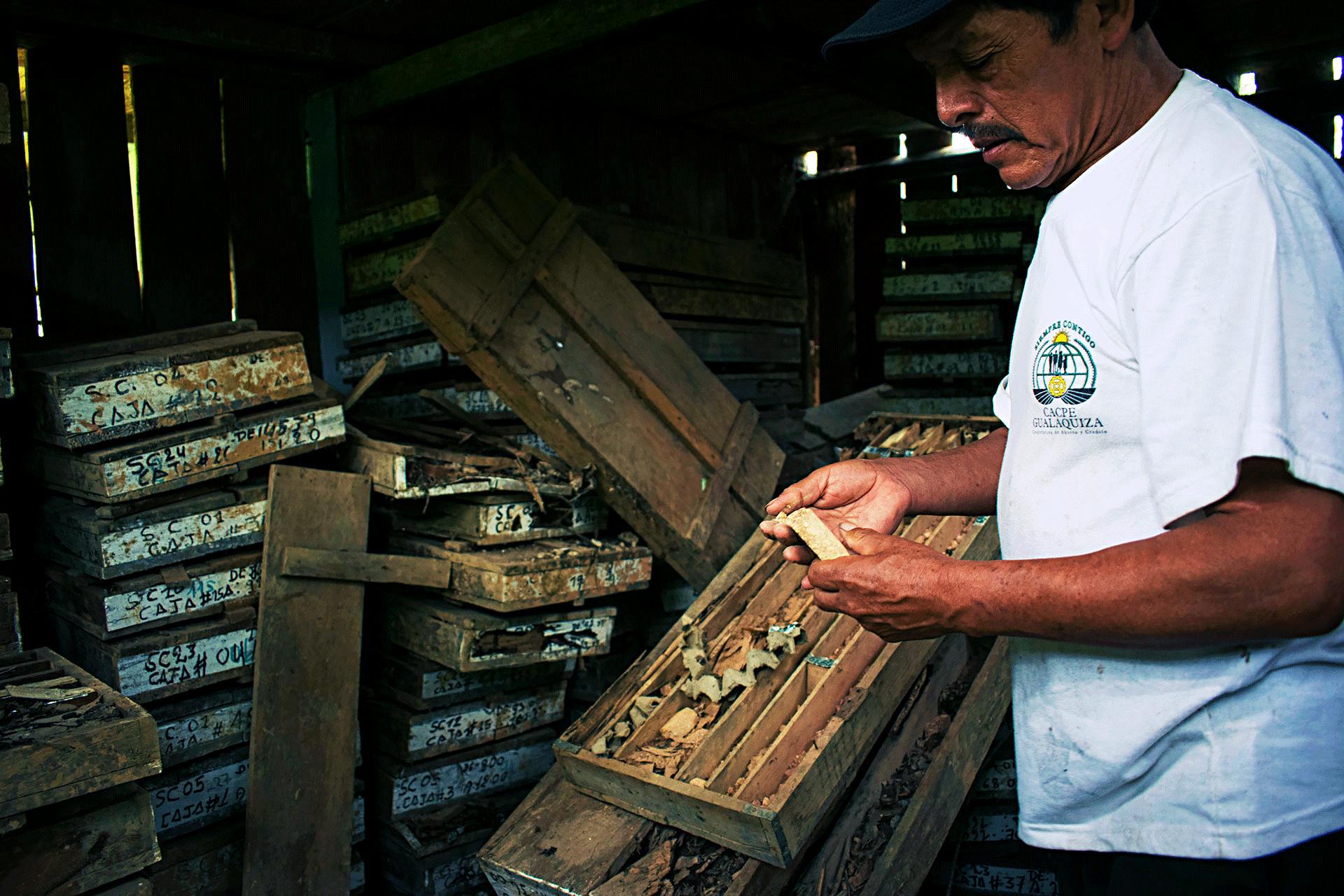
Mario Melo is the lawyer of the Shuar Arutam people and insists that this territory belongs to the Shuar nationality. The historical context is long and complex, but Melo said the Shuar were cornered in their own territory through a combination of the mission of the Salesian monks, the drought of the 1960s in the southern Sierra that led peasants to occupy lands in the Amazon, and the first agrarian reform in 1964. A report by the Fundación Regional de Asesoría en Derechos (Inredh) also mentions that in the 1970s there was a colonization process promoted by the then-Ecuadorian Institute of Agrarian Reform and Colonization (IERAC) “which awarded Shuar ancestral lands to settlers as if they did not exist.”
Although it knew that the area was indigenous ancestral territory, granted property titles to peasants.
Mario Melo.
Melo explained that the State, although it knew that the area was indigenous ancestral territory, granted property titles to peasants. “The people of the Sierra arrived with a different mentality, for them collective property has no meaning so they asked to legalize their name, individual, two, three hectares,” Melo said. They were small and isolated, which did not seem worrying for the Shuar. But everything changed when the peasants sold those titles to the mining companies. In 1998, prospecting began in the Cordillera del Cóndor, an area that had previously been in dispute, was a war zone (three years earlier, Ecuador and Peru had sent soldiers to the banks of the Cenepa River), and civilian activities were banned.
According to Melo, the peasants saw a business opportunity. They asked the State for the deeds in exchange for cultivating the land soon and, once they had the papers, they sold them to the companies.
The company owns that land, but that transaction was not really legitimate
Verónica Potes.
“The company owns that land, but that transaction was not really legitimate. If you go backwards, you’re going to find a time when there was an adjudication by some state organization. That’s the beginning of the dispossession of the Shuar,” said Verónica Potes, a lawyer who specializes in indigenous rights.
One of those few hectare deeds the settlers sold to the miners was Nankints. Explorcobres S.A. owns 150 hectares but the concession given to it by the Ecuadorian state is almost 42,000. Those additional hectares belong to the Shuar Arutam people who, since the last decade of the 20th century, have followed processes for the State to give them titles to a territory that, in theory, the Constitution of Ecuador recognizes as belonging to them, according to Potes.
***

On Feb. 12, 2019, the press room of the Confederation of Indigenous Nationalities of Ecuador (Conaie), in Quito, was full of reporters and cameramen. At the rectangular table, lawyer Mario Melo, accompanied by Shuar leaders, began the press conference and announced that the Shuar Arutam people would take protective action – a legal mechanism to protect human rights – against the Panantza-San Carlos project. He said the main argument was that the state violated the constitutional right to free, prior and informed consultation, an indispensable requirement in any extractive project in Ecuador. It was a commitment that the country also made when it signed Convention 169 of the United Nations International Labour Organization. In areas of exploitation, it basically consists of consulting the inhabitants of ethnic villages whether or not they allow resources to be extracted from their territories.
When the government of Rafael Correa created wording in the Constitution involving the extraction industry, they created models of paper consultations. According to Melo, in the case of Panantza-San Carlos, the cultural identity of indigenous peoples is being disrespected. “Additionally, through violent acts in 2016, the right to a dignified life and integrity was violated,” he said.
Five days after the press conference, in the parish of San Carlos de Limón, in Morona Santiago, Claudio Washikiat, a Shuar leader of Conaie territory, who wears red zigzag marks on his cheekbones, spoke at an assembly of the Shuar communities of Morona Santiago about protective action.
The assembly was held in a community center with a curved zinc roof and a cement multi-sports court and steps painted yellow and green, the colors of the province, symbolizing the condor mountain range, forests and minerals.
In the same place, two years earlier the military set up their tents and lived there for the 30-day state of emergency. Now, however, the attendees, seated in white plastic chairs want to know what will happen to the exploitation of the territory they consider theirs.
Claudio Washikiat, Vicente Tsakimp, president of the Shuar Arutam People, and two other Shuar leaders spoke from the stage, and most of the dialogue is in their language. Attendees gave long commentaries, and the moderating secretary asked them to make concrete proposals. “But are we going to recover the territory?” asked one of the attendees, after they are told what the protection action is for.
It is a question that no one dares to answer.
***
Three days before the assembly in Limón, on the night of Feb. 14, 2019, Claudio Washikiat – round face of hard gestures, an air of superiority over the mestizos and a strengthened leadership- arrived in Tsuntsuim from Quito. He had not returned to the community since December 2016, after the policeman died and President Correa declared a state of emergency.

Trustee Domingo Nayash, the communal man Alvino Pinchupá and his wife Maria Natalia Nankamai, give him a warm reception. In 2016, Washikiat was vice-president of the Interprovincial Federation of Shuar Centres (Ficsh). When the conflict broke out in November, 2016, Washkiat was one of the men who tried to recover Nankints, and he was one of those wanted by police and military as they surveilled small Shuar communities with helicopters and patrols. “That day you disappeared, we thought you had been killed or you had died,” Nayash said.
Washikiat, finished eating an armadillo broth he had been offered as a welcome and rose from the table to say what no one in Tsuntsuim had known until then. He remembered the low-flying helicopters, the armored cars, the tanks and the ambush. He said that when he felt cornered, he threw himself into the ravine full of downed trees that ends at the Zamora River, near where a tarabita (a rope bridge) connects Limón with the rest of the communities and parishes.
Washikiat was in hiding for months because of legal complaints filed against him for the murder of police officer Mejia. Like him, Rosa Tuits and Oswaldo Dominguez, a mestizo community member from Limón, were named as suspects in that murder. But Unlike Washikiat, Rosa Tuits and Oswaldo Dominguez were not at La Esperanza on Dec. 14, 2016 when Mejia died.
According to the Attorney General’s Office, the case of Mejía’s murder is still under investigation. After a month of sending requests for information, the office relied, via e-mail, that charges were filed against the three had been dismissed. The information matches the information disclosed by the Judiciary Council.
The shooting, the helicopter surveillance and the displacement of the inhabitants of Tsuntsuim for four months were not the only forms of violence suffered by the people of the area. Forty-three people, among them Shuar and mestizos, were accused of murder, 22 of attack or resistance, 10 of intimidation, 10 of inciting discord, four of robbery, three of cattle theft, two of possession of stolen goods, two of damage to the property, one of theft and one of possession of weapons.
From January 2009 to December 2018, more than 200 people were prosecuted after demonstrating for a territory free of mining.
The accusations, like those faced by Tuits and Domínguez, took place in a political context in which anyone who resisted or protested was denounced. According to Conaie, Ecuarunari (the Confederation of Peoples of the Kichwa Nationality of Ecuador, which brings together the indigenous peoples of the Sierra) and several human rights organizations, from January 2009 to December 2018, more than 200 people were prosecuted after demonstrating for a territory free of mining.
In Ecuador, the most recurrent violence suffered by defenders of territory during the last decade was the criminalization of protest.
On March 6, 2019, attorney Mario Melo filed the protective action he had announced 22 days earlier.
While in Quito, the organizations that support the Shuar people’s struggle prepared reports, maps on the loss of territory and analyses on the impact of mining. Benito Jimpikit has continued to live on his farm because he still does not have enough to build a new house in Tsuntsuim.
There are still Shuar living in hiding with the weight of murder accusations against them. The families of Tsuntsuim have continued to mourn the loss of their meager belongings. And the 32 displaced people have not been able to return to Nankints.
Sandro Chinkim, one of the 32 violently displaced inhabitants, still speaks bitterly. “The day we were evicted, from that moment on, we were left without land. My whole family had to find shelter. I lost everything.”

